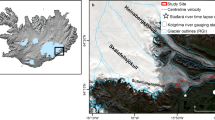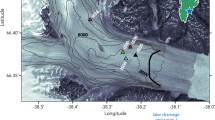Abstract
A rare combination of natural circumstances permits assessment of current theories on water flow beneath glaciers. Outburst floods from the subglacial lake Grímsvötn in Iceland took place before, during and after surging of Skei∂arárjökull, the glacier beneath which the outburst floods drain. The observable drainage patterns associated with these floods show the different nature of the basal water conduit system of the glacier during surge and non-surge phases. During surge conditions, basal water is dispersed slowly across the bed in a distributed drainage system; but when the glacier is not surging, water is transported rapidly through a system of tunnels.
This is a preview of subscription content, access via your institution
Access options
Subscribe to this journal
Receive 51 print issues and online access
$199.00 per year
only $3.90 per issue
Buy this article
- Purchase on Springer Link
- Instant access to full article PDF
Prices may be subject to local taxes which are calculated during checkout



Similar content being viewed by others
References
Röthlisberger, H. Water pressure in intra- and subglacial channels. J. Glaciol. 11, 177–203 (1972).
Shreve, R. L. Movement of water in glaciers. J. Glaciol. 11, 205–214 (1972).
Lliboutry, L. A. General theory of subglacial cavitation and sliding of temperate glaciers. J. Glaciol. 11, 21–58 (1968).
Iken, A. The effect of the subglacial water pressure on the sliding velocity of a glacier in an idealized numerical model. J. Glaciol. 27, 407–421 (1981).
Walder, J. S. Hydraulics of subglacial cavities. J. Glaciol. 32, 439–445 (1986).
Kamb, B. Glacier surge mechanism based on linked cavity configuration of the basal water conduit system. J. Geophys. Res. 92, 9083–9100 (1987).
Walder, J. S. & Fowler, A. Channelized subglacial water channels and cavities. J. Glaciol. 40, 3–15 (1994).
Röthlisberger, H. Contribution to discussion of J. Weertman's paper. Can. J. Earth Sci. 6, 941–942 (1969).
Kamb, B. et al. Glacier surge mechanism: 1982–1983 surge of Variegated Glacier, Alaska. Science 227, 469–479 (1985).
Raymond, C. F. & Harrison, W. D. Winter initiation of surges. Abstr. Hydraulic Effects at the Glacier Bed and Related Phenomena (ETH Zürich, (1985)).
Raymond, C. F. How do glaciers surge? A review. J. Geophys. Res. 92, 9121–9134 (1987).
Thorarinsson, S. Some new aspects of the Grímsvötn problem. J. Glaciol. 14, 267–274 (1953).
Thorarinsson, S. Vötnin Stríð. Saga Skeiðarárhlaupa og Grímsvatnagosa (The Swift Flowing Rivers. The History of Grímsvötn Jökulhlaups and Eruptions) (Menningarsjóður, Reykjavík, (1974)).
Björnsson, H. Explanation of jökulhlaups from Grímsvötn, Vatnajökull, Iceland. Jökull 24, 1–26 (1974).
Björnsson, H. Hydrology of Ice Caps in Volcanic Regions (Rit 45, Societas Scientiarum Islandica, Reykjavík, (1988)).
Björnsson, H. Jökulhlaups in Iceland: prediction, characteristics and simulation. Ann. Glaciol. 16, 95–106 (1992).
Gudmundsson, M. T., Björnsson, H. & Pálsson, F. Changes in jökulhlaup sizes in Grímsvötn, Vatnajökull, Iceland, 1934–91, deduced from in-situ measurements of subglacial lake volume. J. Glaciol. 41, 263–272 (1995).
Nye, J. F. Water flow in glaciers: jökulhlaups, tunnels and veins. J. Glaciol. 76, 181–207 (1976).
Spring, U. & Hutter, K. Numerical studies of jökulhlaups. Cold Reg. Sci. Technol. 4, 221–244 (1981).
Clarke, G. K. C. Glacier outburst flood from “Hazard Lake”, Yukon Territory, and the problem of flood magnitude prediction. J. Glaciol. 28, 3–21 (1982).
Pálsson, S., Zóphóníasson, S., Sigurðsson, O., Kristmannsdóttir, H. & Aðalsteinsson, H. Skeiðarárhlaup og Framhlaup Skeiðarárjökuls 1991(Rep. OS-92035/VOD-09 B, Natl Energy Authority, Reykjavík, (1992)).
Acknowledgements
The work was supported by The Research Fund of the University of Iceland, the Icelandic Road Authority and the National Power Company of Iceland. I thank B. Kamb for critically reading the manuscript, and my colleague M. Karlsson for assistance with the writing and presentation.
Author information
Authors and Affiliations
Corresponding author
Rights and permissions
About this article
Cite this article
Björnsson, H. Hydrological characteristics of the drainage system beneath a surging glacier. Nature 395, 771–774 (1998). https://doi.org/10.1038/27384
Received:
Accepted:
Issue Date:
DOI: https://doi.org/10.1038/27384
This article is cited by
-
Study of dynamics in surface ice flow rate of glaciers in Hunza basin, Karakoram
Environmental Science and Pollution Research (2023)
-
The hazardous 2017–2019 surge and river damming by Shispare Glacier, Karakoram
Scientific Reports (2020)
-
Volcanoes and climate: the triggering of preboreal Jökulhlaups in Iceland
International Journal of Earth Sciences (2020)
-
Dynamic vulnerability revealed in the collapse of an Arctic tidewater glacier
Scientific Reports (2019)
-
Characteristics of mountain glacier surge hazard: learning from a surge event in NE Pamir, China
Journal of Mountain Science (2019)
Comments
By submitting a comment you agree to abide by our Terms and Community Guidelines. If you find something abusive or that does not comply with our terms or guidelines please flag it as inappropriate.



